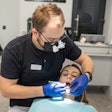Estrogen may increase the movement of precancerous cells in the mouth and thus promote the spread of the disease within the oral cavity, according to a new study in Cancer Prevention Research (January 2011, Vol. 4:1, pp. 107-115).
The findings could lead to the development of novel chemoprevention strategies, according to researchers from the Fox Chase Cancer Center.
Margie Clapper, PhD, co-leader of the Cancer Prevention and Control Program at the Fox center, and colleagues had previously reported that estrogen metabolism changes following smoke exposure in the lungs and may contribute to lung cancer (Cancer Prevention Research, June 2010, Vol. 3:6, pp. 707-717).
To find out if this female hormone influences development of head and neck cancer, Ekaterina Shatalova, PhD, a postdoctoral fellow at Fox Chase Cancer Center and researcher on the current study, and colleagues examined the impact of estrogen on precancerous and cancerous cells.
They found that estrogen induces the expression of an enzyme called cytochrome P450 1B1 (CYP1B1), which is responsible for breaking down toxins and metabolizing estrogen. Interestingly, CYP1B1 induction occurred only in precancerous cells, which are neither totally normal nor cancerous. Surprisingly, estrogen did not induce CYP1B1 in cancer cells.
With closer investigation, the researchers found that depleting the expression of CYP1B1 diminished the ability of precancerous cells to move and divide, as compared with similar cells with normal levels of CYP1B1. Estrogen also reduced cell death in the precancerous cells, irrespective of the amount of CYP1B1 present.
"In the future, we would like to find a natural or dietary agent to deplete the CYP1B1 enzyme and see if we can prevent oral cancer at the precancerous stage," Shatalova said. "Our previous studies showed that the CYP1B1 enzyme sits at the hub of changes that occur in the lungs after smoke exposure. We were now able to look at its role in a more direct fashion by removing it from precancerous cells of the oral cavity."
CYP1B1 could be a "wonderful target" in precancerous lesions of the head and neck, added Clapper, "because by attacking it, we might stop these lesions from progressing or moving to a more advanced stage."
In addition, patients diagnosed with head and neck cancer are at a high risk of developing a second primary tumor, which is associated with poorer overall survival. Finding a way to reduce these subsequent tumors could improve patients' survival.
These results may help researchers to "understand factors that cause head and neck cancer, in addition to the traditional risk factors of tobacco and alcohol exposure," said Jennifer Grandis, MD, a professor and director of the Head and Neck Cancer Program at the University of Pittsburgh School of Medicine. However, because these results are limited to a single premalignant cell line, further studies are needed to validate these findings in head and neck cancer in a human population, Dr. Grandis said.
Copyright © 2011 DrBicuspid.com



















